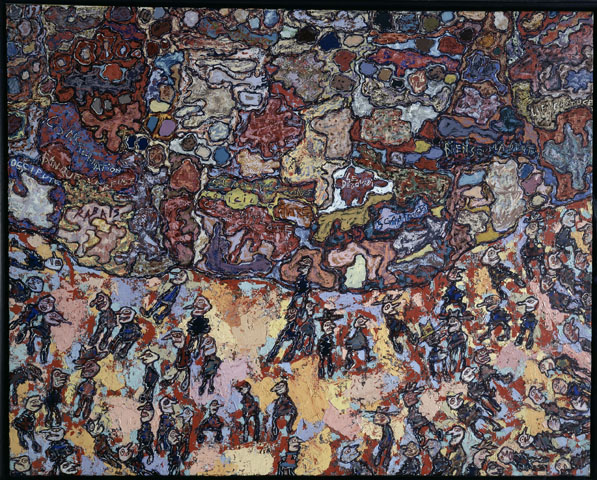Fr : version française / En: english version
mheu, Historical Museum of the Urban Environment
Rue Passagère

1961
129cm x 161cm
oil on canvas
Paris, Musée National d'Art Moderne - Centre Georges Pompidou
© ADAGP, Photo CNAC/MNAM, Dist. RMN / Bertrand Prévost
View this work in the exhibition The Street
The work
Rue Passagère was painted in 1961 following a four-year period (1956-1960) during which Dubuffet experimented with abstraction through works featuring a host of materials including sand, tar, straw and leaves mixed with oil paints (known as Sols, Texturologies and Matériologies). The artist went back to the roots of childhood drawings through what he called Art Brut (outsider art) in 1947, with a style featuring simplified lines, lack of perspective, deliberate slips, lively colors and a rejection of dominant cultural trends, which he saw as suffocating.
The painting also marked the start of an important period for Dubuffet, known as the "Hourloupe Cycle", which he began in 1962 and completed in 1974, during which he again turned his attention to portraying people, demonstrating a highly graphical approach—through the use of color in its simplest form—and to the crowds first seen in La Vie Passagère.
In the same year, 1961, Dubuffet began exploring the use of music with the Danish painter Asger Jorn, leading founder of the Cobra movement.
The artist
Jean Dubuffet was born in Le Havre in 1901, the son of a prosperous family. His father was a wine merchant. At the age of 17, he set off for Paris to study at Académie Julian, where he met Dufy, Masson, Juan Gris and Fernand Léger, whom he befriended. However, the young Dubuffet had yet to find himself. In 1924, he set off for South America. The following year, he took over his father's business in Le Havre. In 1927, he married and in 1929 he set up shop in Paris as a wine merchant.
Yet painting was in his blood. In 1933, he threw himself back into his art, gradually abandoning the wine business. He divorced, remarried and devoted himself to his art from 1942 onwards, enjoying quick success, with an exhibition at the Galérie Drouin in Paris in 1944, then in New York in 1948. In 1949, Clément Greenberg wrote an article on Dubuffet that brought him great acclaim in the United States, where he also met Pollock and Duchamp. Until his death on May 12, 1985, Dubuffet's fame never faltered: shows included a retrospective at the Musée des Arts Décoratifs in Paris in 1960, at the MOMA in 1962, and at the Guggenheim in 1973.
In 1971, the artist created a Foundation in Paris, which stores all archives and has a collection spanning his entire body of work.